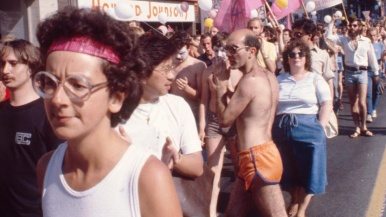The 10 biggest moments in Toronto transportation in the last 50 years
To celebrate Toronto Life’s 50th year, we’re counting down the biggest Toronto moments of the last half-century. This month: a ranking of the trains, roads, strikes and spats that mattered most. Disagree with our choice for number one? Have your say at the bottom

PEARSON’S PIÈCE DE RÉSISTANCE 2004
The new Terminal 1 was much more than a facelift
10 On April 6, 2004, Pearson debuted its elegant new Terminal 1, a light-soaked mass of undulating ceilings, glass walls and grand whitewashed foyers punctuated by splashes of colourful modern art. The complex, part of a $4.4-billion airport redevelopment, wasn’t just more beautiful than its staid predecessor; it was also vastly bigger, with 4.2 million square feet of interior space, and they’ve since added another 1.8 million. Today, the country’s pre-eminent air hub handles some 1,100 flights per day.

THE MONTH THE SIX STOOD STILL 1974
The longest strike in TTC history, by the numbers
9 23 Length, in days, of the strike
40 Percentage wage increase that TTC workers demanded
$5 Maximum hourly wage for TTC drivers in 1974 ($26 in today’s dollars)
1 Number of hitchhikers then-mayor Mel Lastman picked up on day one of the strike
360 Number of privately owned school buses the TTC used as temporary taxis
5,700 Number of TTC employees on strike
2,161 Number of taxis in Toronto in 1974
600,000 Approximate number of TTC users in 1974

GO GETS THE GREEN LIGHT 1967
Regional rail arrives
8 What started with a single line along the shore of Lake Ontario rapidly grew into a network of train tracks and bus routes criss-crossing southern Ontario. GO ushered in the expansion of the GTA, and the system now moves some 271,000 people daily.

TORONTO’S DEADLIEST TRAGEDY 1975
The train-on-bus collision that killed 10
7 On the afternoon of December 12, 1975, a TTC bus stalled on top of GO train tracks in Scarborough, the result of an electrical malfunction in the rear door that caused the brakes to engage. Before the driver could escort everyone out, a passenger train smashed into the bus, turning it to scrap metal, throwing bodies from the scene and killing 10.

THE CONSTANT GARDINER 1966
Downtown’s great divide
6 Torontonians were so ambivalent about the Gardiner that by the time its easternmost section opened in 1966, there was hardly a whiff of fanfare. The highway was a concrete tribute to the car that came with a major cost: cutting off downtown from Lake Ontario. The head-scratching over what to do with it—bury, raze, jack it skyward or something else entirely—persists.

THE BRIDGE TO NOWHERE 2003
The Island airport argument that made Miller mayor
5 An expanded Island airport was pitched as the solution to downtowners’ desire to escape the city without trekking to Pearson. David Miller had other plans. He won votes and the mayoralty thanks in part to his vow to nix the bridge. And that same bloc rallied to stop Bob Deluce’s plan for whisper jets more than a decade later.

UBER’S UNSTOPPABLE ASCENT 2012
The app that threatened to topple the taxi industry
4 Uber offered Torontonians an efficient, cost-effective way to get around a gridlocked city. But instead of quickly innovating, the taxi industry sulked like toddlers, staging a string of traffic-snarling protests that drove customers into the arms of their rivals. Even if Uber gets chastened in the months and years ahead, Torontonians, having experienced a better option, will insist there’s no going back to the pre-Uber days.

SUBWAYS, SUBWAYS, SUBWAYS 2010
A new chapter in transit flip-floppery
3 On his first day in office, mayor Ford raged against his predecessor’s LRT-heavy transit plan, baiting suburbanites with a blunt classist message: if downtowners can have a subway, why can’t you? It distorted the facts, but that didn’t seem to matter. Council quickly fell in line, signing off on a subway extension to Scarborough, a flawed piece of planning that plagues politicians and bureaucrats today.

THE SPADINA SWITCHEROO 1971
An abandoned expressway
2 The Conservative government had long backed a north-south expressway that would snake from the suburbs to downtown. Then, in 1971, new premier Bill Davis withdrew support, and the project quickly crumbled, leaving a stunted Allen and an enduring symbol of the power of informed protest.

A FINE LINE 1966
The Bloor-Danforth subway makes its maiden voyage
1 Perhaps fittingly, it began with a delay. On February 26, 1966, one day after prime minister Lester Pearson took the inaugural ride on the $156-million Bloor-Danforth line, the first trains to carry the public started a half-hour behind schedule. That came on the heels of a string of tragedies—nine workers were killed in separate incidents during construction. Still, the line, which originally ran from Keele to Woodbine, became a triumph, turning the subway into a viable commuter option, spurring development and putting Toronto on the path to modern ways of thinking about how its residents get around.














#3 fizzled when the TTC chair reversed the anti-transit mayor’s plans, and others followed.